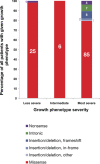Morquio A syndrome-associated mutations: a review of alterations in the GALNS gene and a new locus-specific database
- PMID: 25137622
- PMCID: PMC4238747
- DOI: 10.1002/humu.22635
Morquio A syndrome-associated mutations: a review of alterations in the GALNS gene and a new locus-specific database
Abstract
Morquio A syndrome (mucopolysaccharidosis IVA) is an autosomal recessive disorder that results from deficient activity of the enzyme N-acetylgalactosamine-6-sulfatase (GALNS) due to alterations in the GALNS gene, which causes major skeletal and connective tissue abnormalities and effects on multiple organ systems. The GALNS alterations associated with Morquio A are numerous and heterogeneous, and new alterations are continuously identified. To aid detection and interpretation of GALNS alterations, from previously published research, we provide a comprehensive and up-to-date listing of 277 unique GALNS alterations associated with Morquio A identified from 1,091 published GALNS alleles. In agreement with previous findings, most reported GALNS alterations are missense changes and even the most frequent alterations are relatively uncommon. We found that 48% of patients are assessed as homozygous for a GALNS alteration, 39% are assessed as heterozygous for two identified GALNS alterations, and in 13% of patients only one GALNS alteration is detected. We report here the creation of a locus-specific database for the GALNS gene (http://galns.mutdb.org/) that catalogs all reported alterations in GALNS to date. We highlight the challenges both in alteration detection and genotype-phenotype interpretation caused in part by the heterogeneity of GALNS alterations and provide recommendations for molecular testing of GALNS.
Keywords: GALNS; MPS IVA; Morquio A; lysosomal storage disorder; mucopolysaccharidosis type IVA.
© 2014 The Authors. **Human Mutation published by Wiley Periodicals, Inc.
Figures



References
-
- Caciotti A, Bardelli T, Cunningham J, D'Azzo A, Zammarchi E, Morrone A. Modulating action of the new polymorphism L436F detected in the GLB1 gene of a type-II GM1 gangliosidosis patient. Hum Genet. 2003;113:44–50. - PubMed
-
- Caciotti A, Donati MA, Boneh A, d'Azzo A, Federico A, Parini R, Antuzzi D, Bardelli T, Nosi D, Kimonis V, Zammarchi E, Morrone A. Role of beta-galactosidase and elastin binding protein in lysosomal and nonlysosomal complexes of patients with GM1-gangliosidosis. Hum Mutat. 2005;25:285–292. - PubMed
-
- Catarzi S, Giunti L, Papadia F, Gabrielli O, Guerrini R, Donati MA, Genuardi M, Morrone A. Morquio A syndrome due to maternal uniparental isodisomy of the telomeric end of chromosome 16. Mol Genet Metab. 2012;105:438–442. - PubMed
Publication types
MeSH terms
Substances
LinkOut - more resources
Full Text Sources
Other Literature Sources
Medical

